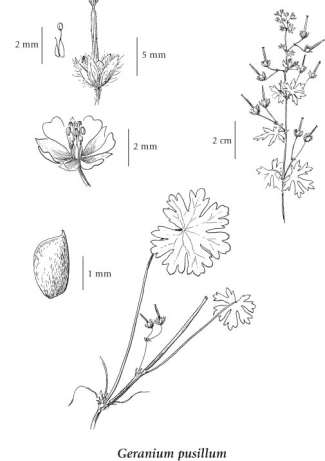Geranium pusillum L.
small-flowered geranium (small geranium; small-flowered crane's-bill)
Geraniaceae (Geranium family)
Introduction to Vascular Plants
small-flowered geranium (small geranium; small-flowered crane's-bill)
Geraniaceae (Geranium family)
Introduction to Vascular Plants
Species Information
General:
Annual or sometimes biennial herb from a taproot; stems prostrate to erect, stiff-hairy and glandular-hairy, 10-50 cm long.
Leaves:
Basal leaves few, rounded in outline, long-stalked, 1.5-7 cm wide, palmately divided into 5-9 broad irregularly toothed and lobed segments; stem leaves few, similar, opposite, short-stalked.
Flowers:
Inflorescence of axillary clusters of usually 2 short-stalked flowers; petals purple, 2-4 mm long, notched; sepals about equal to the petals, callous-tipped; stamens fertile, 5, not fused basally.
Fruits:
Carpels, soft-hairy; styles 7-9 mm long, the beak less than 1 mm long or beakless; seeds glabrous.
Illustration

If more than one illustration is available for a species (e.g., separate illustrations were provided for two subspecies) then links to the separate images will be provided below. Note that individual subspecies or varietal illustrations are not always available.
Illustration Source: The Illustrated Flora of British Columbia
Ecology
Ecological Framework for Geranium pusillum
The table below shows the species-specific information calculated from
original data (BEC database) provided by the BC Ministry of Forests and Range.
(Updated August, 2013)
The table below shows the species-specific information calculated from
original data (BEC database) provided by the BC Ministry of Forests and Range.
(Updated August, 2013)
| Site Information |
Value / Class |
||
|
Avg |
Min |
Max |
|
| Elevation
(metres) |
582 | 510 | 655 |
| Slope
Gradient (%) |
12 | 0 | 25 |
|
Aspect (degrees) |
220 | 220 | 220 |
| Soil
Moisture Regime (SMR) [0 - very xeric; 4 - mesic; 8 - hydric] |
4 | 4 | 5 |
| Modal
Nutrient Regime
Class |
C | ||
| #
of field plots species was recorded in: |
3 | ||
| Modal
BEC Zone Class |
|||
|
All BEC Zones (# of stations/zone) species was recorded in |
|||
|
Source:
Klinkenberg 2013
|
|||